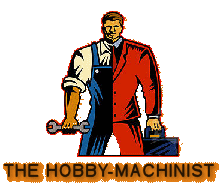I don't think this is correct. I don't think you can easily use axial needle bearings in this design. The base of the broach must necessarily move in a circle. The tip of the broach remains centered in the hole you are cutting. The easiest way to accomplish this is to have a single ball bearing at the base of the broach. This acts a a thrust bearing and allows rotary motion and angular motion away from the axis.
You could only use an axial bearing if the angle of the bearing was very precisely calculated and the length of each broach was exactly the same.
I recently made one of these using a single bearing design.
I finally got around to making a rotary broach for that special project that I have not yet envisioned: I used my Sherline tool cutter and grinder to grind the broaches out of O1 tool steel: I clamped a 1/2" bar in my 5C collet block and mounted the vise with 2.5 deg of angle as viewed from...

www.hobby-machinist.com
As far as the broach goes, the hardest part is grinding the cutting edge and getting it to the correct size. To dish out the end I strongly recommend a Dremel wheel. It sounds primitive but works great.
Robert


